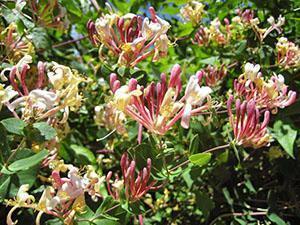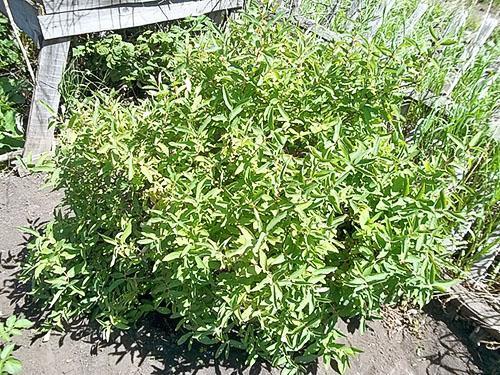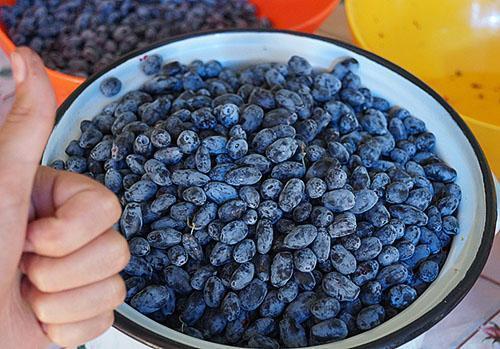Let's get acquainted with the varieties of honeysuckle for central Russia
 Honeysuckle is an amazing healing berry that confidently expands its halo of habitat in an ever larger territory of our country and is deservedly popular with gardeners and farmers. A small sprawling shrub today is often found in the gardens of our compatriots, and breeding institutes do not tire of delighting with new, successful varieties of honeysuckle for central Russia and other regions.
Honeysuckle is an amazing healing berry that confidently expands its halo of habitat in an ever larger territory of our country and is deservedly popular with gardeners and farmers. A small sprawling shrub today is often found in the gardens of our compatriots, and breeding institutes do not tire of delighting with new, successful varieties of honeysuckle for central Russia and other regions.
Advantages of honeysuckle varieties for central Russia

Benefits of Honeysuckle:
- High winter hardiness. Most varieties can withstand temperatures of -47 degrees. Plants affected by frost quickly recover from recurrent frosts and delight with fragrant fruits at a time when other berry crops lose 90% of their yield.
- Long period of life. The honeysuckle bush is able to fully bear fruit for 30 years.
- The high profitability of the crop allows for a small area of the area to receive annually (for several decades) high yields of berries, which are in demand in the market.
- Honeysuckle belongs to early-growing crops, and many varieties are able to please with fruits in the first year after planting.
- In the middle lane of our country, the first berries can be picked in June, when strawberries, raspberries are still at the flowering stage.
 Pest and disease resistance, simplicity in care makes honeysuckle accessible to almost every summer resident. Due to its high immunity, the plant does not require chemical treatment and is a valuable product for baby food.
Pest and disease resistance, simplicity in care makes honeysuckle accessible to almost every summer resident. Due to its high immunity, the plant does not require chemical treatment and is a valuable product for baby food.
The best varieties of honeysuckle for central Russia
Due to the fact that the climate of central Russia is ideal for growing honeysuckle, breeders are successfully working on the creation of new and improvement of the old beloved varieties.
Honeysuckle, for successful fruiting, requires proximity to a pollinator plant. It is better to choose it from varieties that are regionalized in a specific area.
Honeysuckle "Long-fruited"
 This variety arose as a result of pollination of Smolinskaya honeysuckle. The best pollinator for Dlinnoplodnaya honeysuckle is Chelyabinka. It is desirable to plant it at the rate of one bush for ten seedlings of the main variety.
This variety arose as a result of pollination of Smolinskaya honeysuckle. The best pollinator for Dlinnoplodnaya honeysuckle is Chelyabinka. It is desirable to plant it at the rate of one bush for ten seedlings of the main variety.
Honeysuckle variety "Long-fruited" is characterized by:
- weakly growing bush;
- spreading branches with thin, weak shoots of purple color;
- long blue lumpy berries of a refreshing, sweet taste.
Honeysuckle "Long-fruited" is distinguished by early fruiting and amicable return of the harvest (until May 25). The peculiarity and value of this variety is that it easily tolerates severe frosts and is not affected by powdery mildew, grows well in shade and partial shade, is not demanding on the soil, and is not prone to shedding of fruits.
It has proven itself best in the Chelyabinsk region, but with good care, it shows excellent results and has a rich harvest throughout the territory of central Russia.
Advantages and disadvantages of the Blue Spindle variety
 The Siberian group of honeysuckles is the most common among amateurs and professionals.The Blue Spindle variety deserves special praise, which is distinguished by:
The Siberian group of honeysuckles is the most common among amateurs and professionals.The Blue Spindle variety deserves special praise, which is distinguished by:
- high yields;
- compact bush of medium height, dense conical crown;
- oval, pointed veined leaves;
- early ripeness of berries;
- elongated black fruits, covered with a bluish bloom;
- the variety has a tendency to shedding.
Fruits of the “Blue Spindle” variety are used for processing, freezing, like dried fruits. The plant requires pollinators to bear fruit. Such varieties as "Tomichka", "Kamchadalka", "Blue Bird", "Morena".
"Blue bird" at their summer cottage
 This variety is popular with many honeysuckle lovers due to its excellent winter hardiness and high yield. Quite often, less successful varieties are sold under this guise. In order not to be mistaken when choosing, you must familiarize yourself with the description of the “Blue Bird” honeysuckle.
This variety is popular with many honeysuckle lovers due to its excellent winter hardiness and high yield. Quite often, less successful varieties are sold under this guise. In order not to be mistaken when choosing, you must familiarize yourself with the description of the “Blue Bird” honeysuckle.
Features of the variety:
- early maturation;
- high level of resistance to pests and diseases;
- weak shedding of fruits;
- requires pollinators;
- has a low spreading bush, pubescent shoots;
Black berries are distinguished by a blue tint, oval shape, sweet taste with a pleasant aroma. The variety is picky about the planting site and prefers sunny, wind-protected areas. Produces well in rich soil and requires a drainage system. With a lack of moisture, the plant can shed its fruits. Therefore, the land under the honeysuckle must be mulched and irrigated in the heat.
The Blue Bird variety does not tolerate acidic soil: it develops poorly and bears fruit. To fix the problem, it is necessary to process the planting area with lime.
A group planting of seedlings, 8-10 bushes per pollinator bush (no further than 1.5 meters from each other), will provide annual generous fruiting. The honeysuckle variety "Blue Bird" responds well to spring feeding with ammonium nitrate, loosening the soil, adding wood ash and compost to the planting pit.
Honeysuckle "Tomichka": the pros and cons of growing
 Variety "Tomichka" belongs to the group of Siberian selection, is distinguished by high productivity and high-quality fruits, which are used for processing, freezing, fresh consumption, dietary and baby food. The fruits of the Tomichka variety can be easily distinguished from other honeysuckle berries. They are characterized by a depressed apex, a drop-like shape, black, bluish color, a tuberous membrane and thin skin. The bush of the plant is tall, spreading, the shoots are pubescent.
Variety "Tomichka" belongs to the group of Siberian selection, is distinguished by high productivity and high-quality fruits, which are used for processing, freezing, fresh consumption, dietary and baby food. The fruits of the Tomichka variety can be easily distinguished from other honeysuckle berries. They are characterized by a depressed apex, a drop-like shape, black, bluish color, a tuberous membrane and thin skin. The bush of the plant is tall, spreading, the shoots are pubescent.
The main disadvantage of the variety is the high percentage of fruit shedding. From one bush, you can collect up to 2 kg of fruit. The variety cannot be called high-yielding, but it is undemanding to care for, it grows and bears fruit even on poor, loamy soils. The plant requires pollinators to set fruit. "Blue Spindle" "Cinderella", “Pavlovskaya” - these varieties are best suited for pollination “Tomichki”.
Honeysuckle variety "Pavlovskaya"
 A close relative of this variety is the common Kamchatka honeysuckle. It was bred at the Pavlovsk Experimental Station of the All-Russian Research Institute. N.I. Vavilov. The plant belongs to varieties of medium ripening, it is distinguished by good winter hardiness, amicable ripening of berries that are quite large in size (up to 1.6 g). A feature of the variety is that the berries stick to the shoots and rarely crumble, contain a lot of vitamin C and have a dessert, pleasant sour taste. From one bush, you can collect up to 2 kg of fruit. The variety is resistant to recurrent frosts and sudden changes in temperature.
A close relative of this variety is the common Kamchatka honeysuckle. It was bred at the Pavlovsk Experimental Station of the All-Russian Research Institute. N.I. Vavilov. The plant belongs to varieties of medium ripening, it is distinguished by good winter hardiness, amicable ripening of berries that are quite large in size (up to 1.6 g). A feature of the variety is that the berries stick to the shoots and rarely crumble, contain a lot of vitamin C and have a dessert, pleasant sour taste. From one bush, you can collect up to 2 kg of fruit. The variety is resistant to recurrent frosts and sudden changes in temperature.
The plant requires pollinators and the varieties “Tomichka”, “Blue Bird”, “Universal”, “Blue Spindle” do the best with this task. Honeysuckle “Pavlovskaya” was registered in 1987, but only in 2000 it was zoned in the territory of our country.
Central Russia is an ideal place for growing honeysuckle, you just need to choose the right varieties and give them a little love, care and attention.